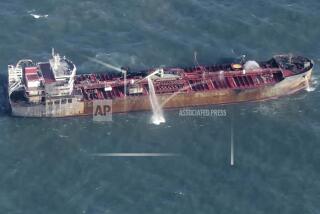Reckless Acts Laid to Fired Alaska Captain : Environment: Oil spill trial opens with the prosecution saying Hazelwood drank heavily. His defense lawyer denies it, calls him ‘calm, cool.’
- Share via
ANCHORAGE — State prosecutors began the trial of fired tanker Capt. Joseph Hazelwood Monday by accusing him of a sequence of reckless acts that they say first led to the disastrous grounding of the Exxon Valdez and then threatened to make it worse.
In opening arguments before a jury of seven women and five men, assistant Dist. Atty. Brent Cole said evidence will show that Hazelwood drank heavily before sailing, left control of the giant tanker in the hands of an unqualified officer and, after the grounding, risked capsizing the vessel by trying to get it off the reef.
But defense attorneys characterized the grounding that spilled 11 million gallons of crude oil as a maritime accident and disputed claims that the former ship’s master drank excessively in the hours before he sailed.
“Alcohol had nothing to do with this accident,” Fairbanks attorney Dick Madson said.
The defense lawyer also told jurors that evidence will show that the captain’s actions after the grounding were “calm, cool” and calculated to save the ship -- which, Madson said, he did.
After months of pretrial legal skirmishes over everything from the admissibility of sobriety test results to the state’s jurisdiction in the case, Monday’s opening arguments launched the first courtroom battle stemming from the nation’s worst oil spill. The trial is expected to last more than six weeks.
It is not clear whether the case will provide much more detail about events leading up to the accident than were already revealed in hearings before the National Transportation Safety Board last May. But this will be the first verdict rendered on the responsibility of the captain whose role has been under scrutiny since March 24, 1989.
Madson said that Hazelwood does not claim to be faultless. “In hindsight everyone would’ve done something differently,” he told jurors.
And the defense contends that Hazelwood’s errors were not made out of recklessness and, therefore, should not be treated as a crime.
Based on the presentations of both sides there appears to be no dispute about some of the key elements of the case.
Hazelwood and two ship’s officers -- the chief engineer and the radio officer -- went into Valdez while the Exxon Valdez was being loaded the afternoon of March 23, 1989.
They returned shortly before the ship was to sail. According to NTSB testimony, the departure time was moved up while the captain was in Valdez.
The ship sailed shortly after 9 p.m. under the control of state port pilot Ed Murphy and Hazelwood spent much of the next two hours in his cabin. The defense says he was doing paper work.
When the pilot left the ship, Hazelwood ordered a course change to skirt icebergs accumulating in the shipping lane and then turned over control of the ship to Third Mate Gregory T. Cousins with orders to make certain course changes later. Hazelwood then again went below to his cabin.
He did not return until the grounding occurred shortly after midnight.
After the grounding, Hazelwood ordered the ship’s engines brought back to full ahead and ordered a series of rudder changes. The state says he was trying to extricate the vessel from Bligh Reef. Defense lawyers say he was trying to secure it on the reef.
Cole recited a litany of what he called reckless acts that began in a Valdez bar before Hazelwood’s ship sailed into maritime history.
Cole said witnesses will testify that Hazelwood was seen drinking vodka at the Pipeline Club during the afternoon of March 23, that he drank beer shortly before boarding the vessel and that his actions aboard ship indicated “poor judgments.”
Specifically, he cited Hazelwood’s failure to be on the ship’s bridge for much of the time prior to the accident, the captain’s order to put the ship at least briefly on auto pilot, his ordering the ship to full speed ahead knowing there were icebergs in the region and his leaving the ship in control of a third mate who didn’t have a pilotage certificate for Prince William Sound.
But Madson scoffed at those claims, chiding the state for giving the impression “that this (was) the Titanic going through the ice.” The defense lawyer argued that skirting the ice was a routine and safe maneuver.
He also said that the autopilot was no factor since it was turned off 15 minutes before the accident, that the captain was “only 13 steps from the bridge” in his cabin and that the third mate was qualified to navigate even though he had not completed what Madson characterized as a simple map test.
The defense attorney also said that no one -- not the state port pilot, crew members or Alyeska Oil Terminal guards -- noticed any impairment of Hazelwood’s faculties.
“The clincher,” Madson said, was that the Coast Guard decided against taking Hazelwood into Valdez for a sobriety test in the hours immediately after the grounding because “they wanted him to stay in charge of the ship.”
Madson said that would have been the last thing anyone wanted if the captain’s judgment had been impaired.
More to Read
Sign up for Essential California
The most important California stories and recommendations in your inbox every morning.
You may occasionally receive promotional content from the Los Angeles Times.













